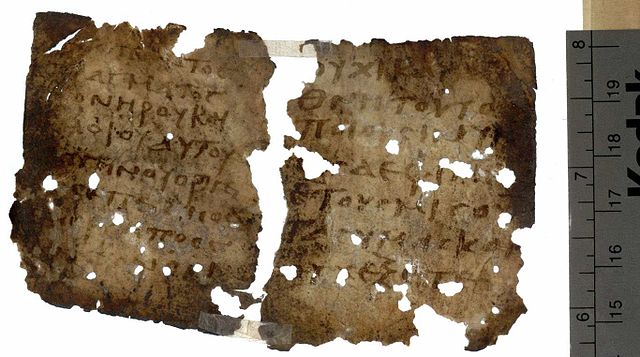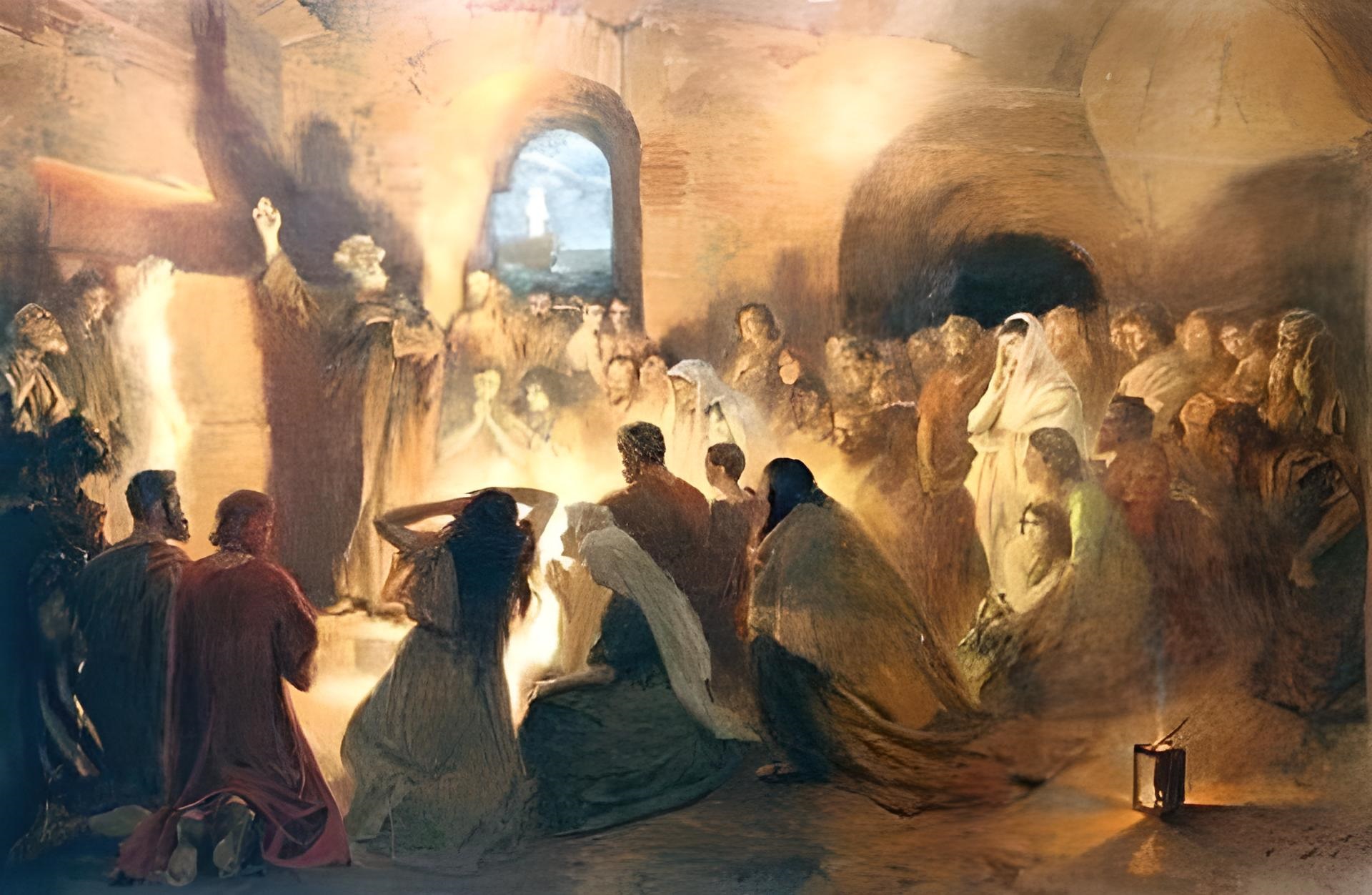The Didache—or The Teaching of the Twelve Apostles—ranks among the hidden jewels of early Christian literature. Though its origins stretch back to the late first or early second century, it came to modern attention only in 1873, when a manuscript was discovered by Philotheos Bryennios in Istanbul. Ever since, scholars and believers alike have marveled at how this short text, though not included in the biblical canon, illuminates the everyday faith and practice of the Church’s first generations. By combining straightforward ethical instruction (“The Two Ways”) with guidelines for Baptism, the Eucharist, and community leadership, the Didache stands as a bridge between the apostolic witness of the New Testament and the later doctrinal and liturgical developments we know in Catholic tradition.
Table of Contents
Historical Background
Discovery and Manuscripts
For centuries, the Didache survived in obscurity, hinted at in the writings of Church Fathers but presumed lost. That changed dramatically when an 11th-century manuscript was found in 1873 at the Jerusalem Monastery of the Most Holy Sepulcher in Istanbul. Suddenly, historians and theologians had in hand a largely complete text of what was believed to be an early Christian “church order.” This discovery made front-page news in the world of biblical and patristic studies, sparking renewed interest in how the early Church lived and prayed.
Provenance and Dating
Scholarly opinion generally dates the Didache to somewhere between A.D. 70 and 120, placing it in close proximity to or shortly after some New Testament writings. This situates it in the turbulent decades following the destruction of the Jerusalem Temple (70 A.D.), when nascent Christian communities were organizing themselves in a rapidly changing religious landscape. The Didache’s tone—practical, pastoral, and community-focused—underscores its function: it was likely a training manual for catechumens, traveling missionaries, or newly baptized believers seeking to integrate the faith deeply into daily life.
Importance as a Post-Biblical Document
While it never made its way into the New Testament canon, the Didache’s antiquity, brevity, and clarity have long earned it respect among scholars and church leaders. It reveals how the earliest Christians understood moral uprightness, liturgical worship, and community leadership. In that sense, the Didache helps us trace a direct line from the Apostolic Age to the post–Tridentine heritage, clarifying continuity with the Church’s later traditions.
Content Overview
Part I: The Two Ways
The Didache begins with a moral treatise known as “The Two Ways”: the Way of Life and the Way of Death. This section outlines practical, everyday virtues, rooted in the commandment to love God and neighbor, contrasting them with vices that lead to spiritual ruin. The teaching is stark, reminiscent of Old Testament wisdom literature and Jesus’ Sermon on the Mount, yet it remains deeply practical.
- Spiritual Resonance for Today: The “Way of Life” echoes Catholic moral teaching on humility, charity, sexual ethics, and honesty. These timeless directives encourage believers to cultivate holiness at the personal and communal level, reminding us of how virtue and vice shape our hearts.
Part II: Liturgical and Sacramental Instructions
After laying out a moral framework, the Didache shifts to sacramental life:
- Baptism: It prescribes baptizing “in the name of the Father, and of the Son, and of the Holy Spirit,” ideally by immersion in living water. Recognizing pastoral realities, it allows pouring water over the head three times if full immersion isn’t possible.
- Fasting and Prayer: The Didache instructs believers to fast on Wednesdays and Fridays, distinguishing Christian practice from Jewish fast days. It also directs the faithful to pray the Lord’s Prayer thrice daily, an early precursor to fixed hours of prayer.
- Eucharist: One of the most fascinating elements is its form of thanksgiving over the cup and the bread. Though less developed than later Catholic liturgies, the text’s eucharistic prayers highlight themes of unity, thanksgiving, and expectation of the world to come—core facets of the Catholic Mass to this day.

Part III: Church Leadership and Community Life
Throughout the Didache, we catch glimpses of a developing hierarchy. The text calls for appointing bishops and deacons, emphasizing that these officials must be worthy, humble, and honest. While traveling prophets and teachers still appear in the Didache’s pages, a stable local leadership is clearly emerging—a signpost toward the structured ecclesiology we find in the later Church.
- Practical Ethics: Concerned that some itinerant preachers might exploit Christian hospitality, the Didache provides specific checks (e.g., limits on how long they may remain) to prevent abuses. This vigilant moral approach highlights how early communities balanced generosity with prudence.
Part IV: Eschatological Outlook
The Didache’s final chapter carries an apocalyptic note, reminding believers to remain vigilant for the second coming of Christ and the final judgment. While not as elaborate as the Book of Revelation, it reinforces the Church’s perennial theme: live uprightly now, with eyes fixed on God’s reign. Even from this early date, Christian moral life was suffused with hope in the Lord’s return.
The Didache’s Place in Catholic Tradition
Patristic Endorsement
Although not universally cited, some Church Fathers allude to a text called “The Teaching of the Apostles,” with content overlapping the Didache. Fathers such as St. Athanasius listed a “Teaching” among recommended reading for converts, reflecting its high regard. It never assumed the status of canonical Scripture, yet it functioned as an important witness to apostolic-era tradition.
Influence on Later Catholic Rites and Devotions
We can observe how certain blessings, prayers, and moral admonitions in the Didache likely informed later liturgical developments:
- The Eucharistic prayers for the bread and cup show remarkable parallels to early Anaphoras used in the second and third centuries.
- The repeated Lord’s Prayer resonates with the Catholic monastic practice of daily offices.
- The Didache’s moral clarity in “The Two Ways” reappears in various catechisms, from the Council of Trent’s Catechism to modern resources.
Why Modern Catholics Should Care
For Catholics living centuries after the Apostles, the Didache is an early “user’s manual” for Christian life, revealing that many beloved aspects of the faith—sacramental worship, hierarchical structure, and moral seriousness—developed from seeds planted in that earliest soil. Studying it can inspire renewed conviction that our present practices flow from a living continuity stretching back to apostolic times.
Relevance for Contemporary Catholic Life
Recovery of the Ancient Sense of Community
In an age often marked by individualism, the Didache reminds us that Christian identity is intrinsically communal. Its repeated insistence on welcoming travelers or instructing novices highlights the solidarity that should mark the Body of Christ. Parishes today can take cues from this, emphasizing hospitality and careful moral discernment.
Invitation to Deeper Participation
Because the Didache addresses worship not in abstract theology but in “how-to” directions, it invites modern believers to reflect similarly on their practice of the faith. Its emphasis on prayer, fasting, and the Eucharist underscores that liturgy is not a weekly add-on but the heart of Christian existence. By recentering on these scriptural and traditional pillars, we can foster spiritual renewal in parish life.
Resource for Catechesis and Spiritual Renewal
- Lectio Divina: The Didache’s short chapters lend themselves to prayerful reading, perhaps during Lent or Advent.
- RCIA & Adult Faith Formation: Introduce inquirers to the Didache as a vibrant snapshot of early Christian discipleship.
- Small-Group Study: Encourage Catholic groups to study the Didache alongside New Testament passages, noting how it aligns with or sheds light on Scripture.

Connection to the Catholic Legendary Tradition
The Didache’s teachings on Baptism and Eucharist underscore how early Christians lived the “mythic dimension” of Christ’s saving work. Its liturgical instructions convey the core of this sacred narrative: death to sin, rebirth in Christ, and perpetual thanksgiving.
In traditional Catholic communities, the Didache is prized as evidence that foundational aspects of Catholic worship—especially the Eucharistic liturgy and hierarchical order—have been present since the Church’s earliest days. It testifies that Catholic tradition is not a medieval innovation but rather an unbroken chain reaching back to apostolic origins.
With its firm ethical directives and sense of communal responsibility, the Didache anticipates a profound transformation of Western culture. By emphasizing love, charity, and Eucharistic unity, it helped shape the moral framework that, over many centuries, would deeply influence entire civilizations.
Practical Takeaways and Reflection
Personal Integration
- Examination of Conscience: Reflecting on “The Two Ways” in the Didache can help believers identify moral strengths and weaknesses in daily life.
- Liturgical Appreciation: Praying the Lord’s Prayer in the mindful manner described by the Didache can rekindle devotion to our Father in heaven.
Suggestions for Study
- Choose a Reliable Translation: There are several modern English versions. Pick one with solid footnotes or commentary.
- Pair with Scripture: Notice parallels, e.g., Didache 8 with Matthew 6 (Lord’s Prayer), or the eucharistic instructions (Didache 9–10) with 1 Corinthians 10–11.
- Focus on the Heart of Worship: The prayers for the bread and cup can be read devotionally before or after Mass, connecting present practice to the early Church.
Community Application
- Parish Workshops: Offer a one-night event introducing the Didache. Show how it exemplifies hospitality, moral seriousness, and sacramental reverence.
- Enrichment Courses: Incorporate it into adult faith formation or deacon training, highlighting how the earliest Christians ordered communal life.
- RCIA Integration: For catechumens or candidates, the Didache may echo their own journey from “outsider” to fully initiated Catholic.
Conclusion
Though under a hundred verses long, The Didache brims with insight into how the first Christians joined moral uprightness with sacramental worship and communal integrity. Far from a relic, it remains a living testimony to our roots in the Apostolic Age. By reading or praying with the Didache, modern Catholics can rediscover the fresh vigor of ancient faith: moral clarity, sacramental depth, and an ardent hope in Christ’s return. Let its pages remind us that the Church’s earliest instructions still guide hearts eager to encounter the Risen Lord and to shape our world according to His love.
In short, the Didache proves that the very earliest Christian communities—though geographically scattered and beset by trials—possessed a clear sense of communal identity, moral vision, and liturgical form. We do well to incorporate its wisdom, letting these “earliest post-biblical Christian instructions” refine how we pray, how we love, and how we live together in communion with the triune God.



